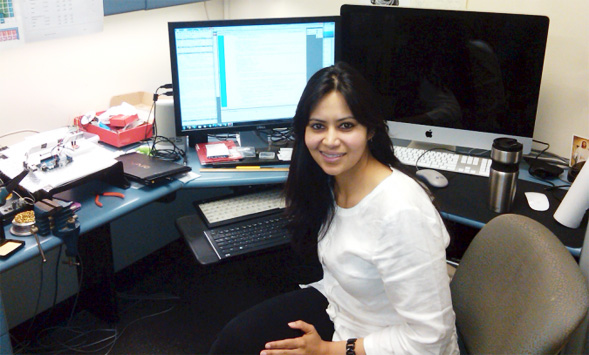Generating Change
Mahasweta Sarkar's engineering research is moving society toward a highly networked future.

This story is part of a series exploring women in engineering at SDSU.
In a virtual world, Mahasweta Sarkar’s avatar could easily be a woman warrior, slaying stereotypes and leading her troops to victory on the field of electrical and computer engineering.
A character not too far removed, in fact, from the real-life Sarkar, protagonist in a profession where the percentage of women barely reaches double digits.
“It’s a mindset,” said the San Diego State associate professor, when asked why women seem reluctant to consider engineering careers.
“Often they come from an environment where they never see themselves in these fields. Yet, the women students I have taught are focused and competent and do just as well as the male students after graduation.”
Hooked on technology
Born in Calcutta, India, Sarkar never had trouble imagining herself as a practitioner of the science, technology, engineering and mathematics (STEM) disciplines. Her engineer father encouraged his daughters to follow in his footsteps. Mahasweta’s sister did so, but Sarkar breached the trend to major in chemistry.
Then she moved to San Diego with her engineer husband during a time of rapid-fire developments in technology. Sarkar was hooked.
She enrolled at SDSU for a second bachelor’s degree—this time in computer science and engineering—and completed a Ph.D. in computer engineering at UC San Diego. After a brief stint as a research scientist for SPAWAR, Sarkar returned to academia.
“The independence of the teacher-scholar model at SDSU inspires me to work harder and with a greater commitment,” she said.
Good connections
Sarkar, together with post-doctoral researcher Christopher Paolini and several SDSU graduate students, is currently at work on creating a wireless network and corresponding mobile application—or app—to assist people with similar interests in connecting at large events, such as professional conferences and college career fairs.
Sarkar and Paolini developed the project as participants in the competitive National Science Foundation’s (NSF) I-Corp program, which supports commercialization of technologies developed as a result of NSF-funded research.
The software will be tested at SDSU’s Oct. 24 Engineering and Sciences Career Fair to direct students to the recruiters most likely to hire them. It matches a student’s resume to an ideal profile created by the recruiter.
Wireless health
Sarkar is also exploring a larger role for wireless networks in the field of health. Her research examines the feasibility of using existing wireless technologies like Bluetooth to deliver a patient’s vital biological statistics directly to the relevant doctor or medical technician through biosensors placed strategically on a patient’s body.
In Sarkar’s vision of the future, the world will be “a highly networked place in which smart appliances impact the social, medical and professional aspects of our lives in ways we could not even comprehend 10 years ago. My current research is a step in that direction,” she said.
Sarkar is also director of the Wireless Networks Research Group at SDSU and was instrumental in creating the NSF-funded Wireless Multimedia Communication and Networks Laboratory in the Department of Electrical and Computer Engineering.



